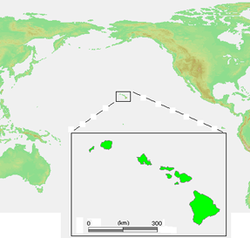Hawaiian monarchy
| Kingdom of Hawaiʻi | ||||||||||||||
| Aupuni Mōʻī o Hawaiʻi | ||||||||||||||
|
||||||||||||||
|
||||||||||||||
Motto
|
||||||||||||||
Anthem
|
||||||||||||||
|
Kingdom of Hawaii
|
||||||||||||||
| Capital | ||||||||||||||
| Languages | Hawaiian, English | |||||||||||||
| Religion | Church of Hawaii | |||||||||||||
| Government |
|
|||||||||||||
| Monarch | ||||||||||||||
| • | 1795–1819 | Kamehameha I (first) | ||||||||||||
| • | 1891–1893 | Liliʻuokalani (last) | ||||||||||||
| Kuhina Nui | ||||||||||||||
| • | 1819–1832 | Kaʻahumanu I (first) | ||||||||||||
| • | 1863–1864 | Kekūanāoʻa (last) | ||||||||||||
| Legislature | Legislature | |||||||||||||
| • | Upper house | House of Nobles | ||||||||||||
| • | Lower house | House of Representatives | ||||||||||||
| History | ||||||||||||||
| • | Inception | May, 1795 | ||||||||||||
| • | Unification | March/April 1810 | ||||||||||||
| • | Constitutional monarchy | October 8, 1840 | ||||||||||||
| • | Occupation by the United Kingdom | February 25 – July 31, 1843 | ||||||||||||
| • | Anglo-Franco Proclamation | November 28, 1843 | ||||||||||||
| • | Monarchy overthrown | January 17, 1893 | ||||||||||||
| • | Defunct | January 24, 1895 | ||||||||||||
| Population | ||||||||||||||
| • | 1800 est. | 250,000 | ||||||||||||
| • | 1832 est. | 130,313 | ||||||||||||
| • | 1890 est. | 89,990 | ||||||||||||
| Currency | ||||||||||||||
|
||||||||||||||
| Today part of | ||||||||||||||
The Kingdom of Hawaiʻi originated in 1795 with the unification of the independent islands of Hawaiʻi, Oʻahu, Maui, Molokaʻi, and Lānaʻi under one government. In 1810 the whole Hawaiian archipelago became unified when Kauaʻi and Niʻihau joined the kingdom voluntarily and without bloodshed or war. Two major dynastic families ruled the kingdom: the House of Kamehameha and the House of Kalākaua.
The kingdom won recognition from major European powers. The United States became its chief trading partner, and the kingdom was watched jealously lest Britain, Japan, or another power threaten to seize control. Hawaii adopted a new constitution in 1887 to reduce the absolute power of King Kalākaua. Queen Liliuokalani, who succeeded Kalākaua in 1891, tried to restore the old order, but was overthrown in 1893, largely at the hands of United States citizens. Hawaii became a republic until the United States annexed it in 1898.
Before the founding of a formal, united kingdom, the islands were all ruled by independent aliʻi nui or "supreme executives". All of these rulers were believed to come from a hereditary line descended from the first Polynesian, Papa, who would become the earth mother goddess of the Hawaiian religion. Captain James Cook stumbled across the islands, but was killed while attempting to kidnap the aliʻi nui of Hawaii Island in 1779. Three years later Hawaii was passed to Kalaniʻōpuʻu's son, Kīwalaʻō, while religious authority was passed to the ruler's nephew, Kamehameha.
...
Wikipedia




